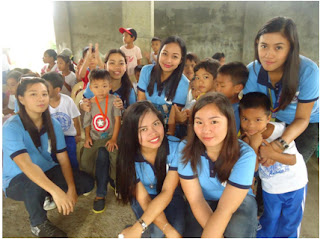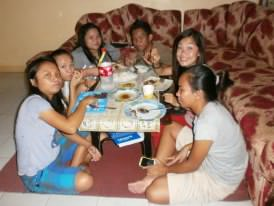BANIG: ANG PAGRARA
Elizabeth T. Bautista and Elgene Joy Sañol BEEd 3-A
BANIG HAND WAVING
- The brown mat (banig) is commonly used by Filipino for sleeping, sitting, house display, hotel designs, etc.
- Banig weaving is a genuine treasure handed
down as a tradition or a trade from one generation to another as it is widely
practiced in the country.
Linkages:
Education
-
Cultural practice may be linked to livelihood education
-may
be considered as a form of art
- preserved the priceless tradition of their
forefathers
Socio-cultural
-cultural display:
- showcases the country's various handicrafts, cultures, and
delicacies, focusing specifically on the native hand woven mats known as “banig
Economic
- banig (bariw) weaving as
means of livelihood
-promote banig (brown mats) and
sub-products of banig as their product.
-encourage the banig weavers
that the banig they produced could possibly turn into a highly valuable item
that can be known not only in the province but also in the international
market.
Health
- Body protection
- It can decrease the occurrences of sickness from too much
cold
Environment
-cutting of pandan leaves may cause extinction of the plant
__________________________________________________________________________________________________________________________________
Ang Pagrara Sang
Banig
Narrative:
It was late in the afternoon, we found
ourselves in the native and small house of Lolo Elias, 85 years old, has wife
named Lola Berheda with four children. Their house is located at the near side
of the Jaycon Elementary School. They are called as “Umuruli” because they came
from far mountains of Aklan and Leon. According to Lolo Elias, the biggest
reason why they left mountain because they wanted to send their children in a
good quality of education in the plain that has enough number of teachers. In
their place, there is no exact schedule for teacher to come and teach the
“tumandok” (people living in their place). While having the conversation to
Lolo Elias, we noticed Lola Berheda at the side doing the mat weaving. We asked
her, “La, sa diin kamu nagakuha sang ginaubra niyo nga banig?” she answered
immediately. “Pandan day-a duro tuya sa ubos ha”. And because we are interested
of the exact appearance of the pandan plant, we look for it. We went down the
hill to see the pandan plant.
Lolo said, farming was
their livelihood before when they were still in the mountains. But when they transferred in the lowlands,
they find weaving as a source of income as well as past time activity in their
home. But the banig (mat) weaving is
not sufficient for an income. The product is a skillful process.
Lolo Elias as a manugbanig
(a person who weaves banig), teach us the process of doing
the “banig” weaving as some sort of a spell implied with
hard work, determination and patience. He together with his wife, simply cut
the leaves using sanggot (an
arc-shaped cutting tool) and a long slender bamboo
pole to reach the leaves of high-grown pandan plant, the process locally known
as the pagsasa.
They gather and bundle
the slashed leaves for stripping off thorns along the edges and into the middle
ridge called as paghapnig (bundling).
By removing the ridge, the leaf is divided into two. Each leaf is piled
separately until the bundle is stripped off with thorns known to them as pagriras
(stripping off). The
leaves will be tightly tied up in bundle so that each piece will not curl up as
it dries.
The Pagbulad or sun or air drying phase follows.
Sun drying of pandan leaves under direct sunlight gives it a shiny brown tone
and strengthens the fiber. Air-dried leaves are durable compared to the
sun-dried one. Air-dried leaves create blackish spots or molds that destroy the
natural luster of brown mats; however, the molds fall off easily during
weaving.
The pagpalpag or the hammering phase is
gradually done by beating the pandan leaves against a flat stone until they
become soft and pliable with the use of a wooden club known as sampok.
Paglikid is a process of keeping
the softness of the pandan leaves and prevents the leaf strips from becoming
stiff and crisp. The leaf is rolled one after the other in a round form;
tightly rolling the leaf sustains its softness and elasticity. The unwinding of
the linikid to straighten the spiraled pandan leaves is
called pagbuntay.
Then follows the pagkulhad or
the shredding of pandanleaves into a desired strand through the kurulhadan
or splicer; a wooden-based shredder. Pagkyupis is the
preparatory process to the weaving proper. Generally, pandan strands are folded
into halves. Every kyupis consists of four strands, folded
together in pairs; horizontally and vertically, with the glossy brown color in
the outer surface.
Taytay is the framework of the entire mat. During
this step, the size and the length of the mat is already assured. The width
dimensions will be determined by weaving at the sides forward, making the
edge-line on both sides of the mat known as sapay. Hurip is
the folding of the remaining strands on the sides or edge-line to keep the
weave tightly locked in place. The process also refers to the repairing of
worn-out and damaged mat during weaving or due to continued use.
Gutab is the final stage
in mat weaving. It is done by eliminating and cutting unwanted strands in the
mat, including the excess strands after the hurip has been done.
They can produce a one
person-sized “banig” for about one day. They sell it the neighborhood, school
and in the town market. They please their finish products on their nephew for
an easy transport. But they cannot avoid
that there will be a day that their banig will be not bought by people. They
are just thankful for any amount of what they had worked.
Through the interview, we
had known thebanigweaving can be one of a good source of family income. Even
though that it needs time and effort, it still can help. Lolo Elias, stressed
that this greatly helps his family expenses and education purposes of his grand
children. Now, we had known the living in Libot, Calinog.
They can produce a one
person-sized “banig” for about one day. They sell it the neighborhood, school
and in the town market. They please their finish products on their nephew for
an easy transport. But they cannot avoid
that there will be a day that their banig will be not bought by people. They
are just thankful for any amount of what they had worked.
Teaching Linked to Banig Weaving
The project method can be
used as the strategy in teaching how to weave a banig. Like banig making, there
are also processes to be followed in project method. The purposing, planning
and executing are the steps in the project method.
Banig making is best to
teach in Technology and Livelihood Education. In this way, we can teach the
students the correct processes of weaving the banig. It is also one alternatives
or source of income when there is materials that can be found near their places
or houses.
















